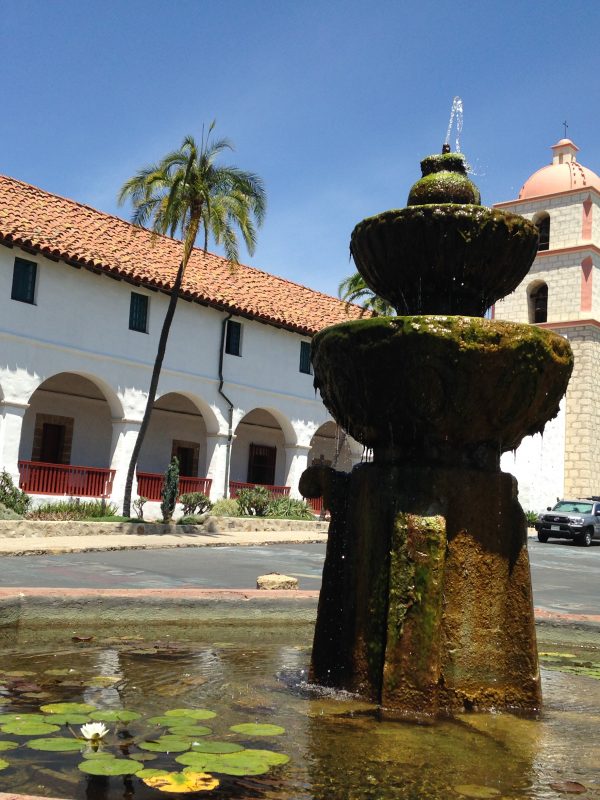Traveling along Route 1, next to the Pacific, is a spectacular experience thanks to the natural beauty of the California coast and parks like Point Lobos, the Hispanic history of cities like Santa Barbara and San Luis Obispo, Hearst Castle, and the lovely Carmel atmosphere.
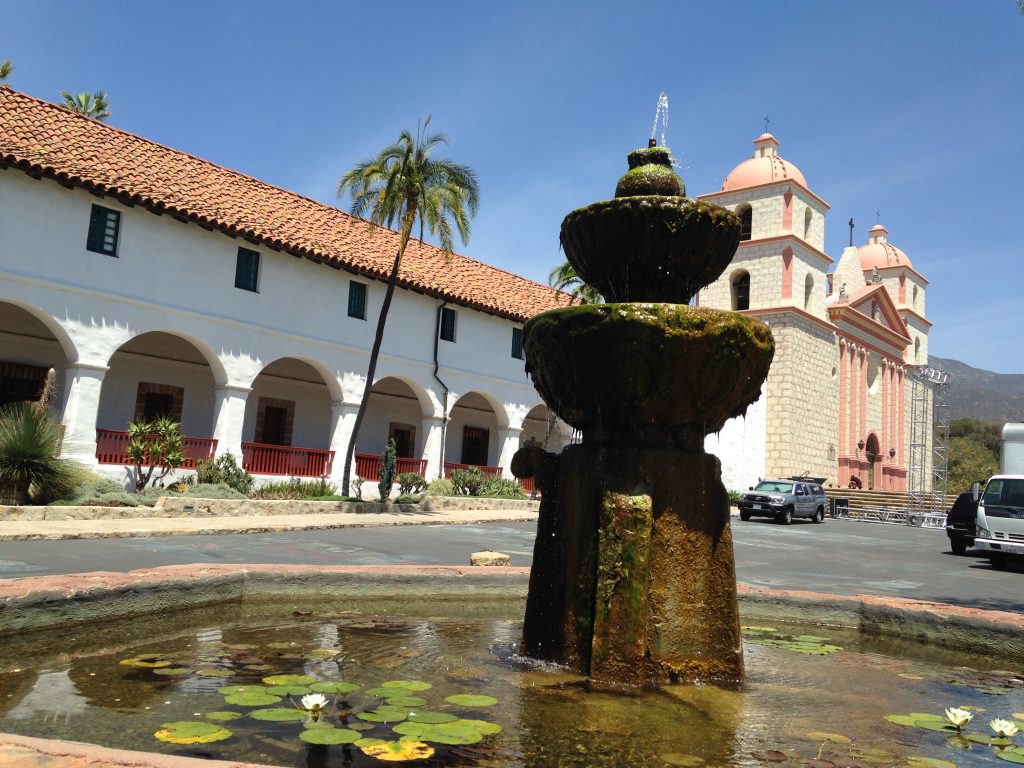
DAY 1 – To fully enjoy this trip, we spent almost a week here, despite being able to go from Los Angeles to San Francisco in less than seven hours. Our first stop, which was for two nights, was at the Hilton Fess Parker. This is an ideally located beachfront hotel in Santa Barbara, a small town just 90 miles from Los Angeles. Our huge room, with a very comfortable bathroom with a jacuzzi, was in the Bouganvilla Building. From the terrace we were able to enjoy a beautiful garden, and in the distance, a view of the sea. The hotel was right next to State Street, which is filled with restaurants and shops, and the hotel has a large parking area and tennis courts.
On the way to Santa Barbara, we had lunch in Solvang, a picturesque Danish village where we ate the best pancakes in California and visited their little shops.
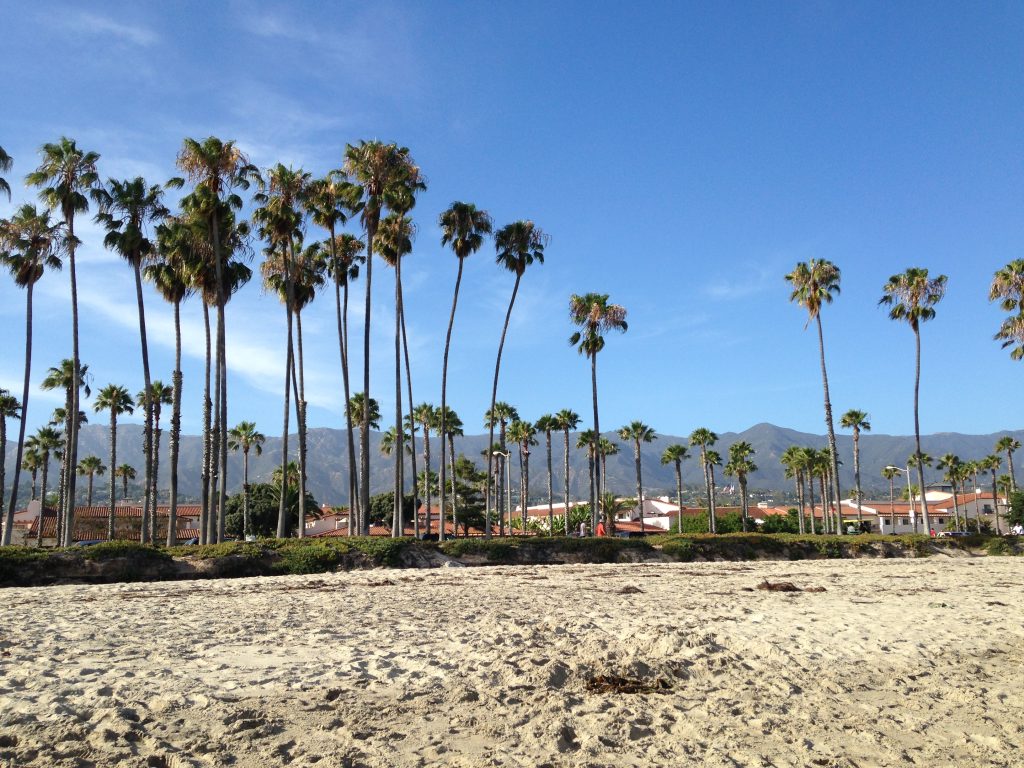
The cozy little town of Santa Barbara, only 42 square miles and with fewer than 90,000 residents, sits between the Santa Ynez Mountains and the Pacific Ocean. Because of its Mediterranean climate, it is considered the American Riviera and is often visited by actors such as Jennifer Aniston, John Travolta, Bo Derek, and personalities such as Ellen de Generes.
We found Santa Barbara to be very Spanish and Mexican, with its streets having Spanish names celebrating its heritage. The Portuguese explorer Joao Cabrillo arrived at the channel of what is now Santa Barbara, on behalf of Spain, in 1542. In 1602 the explorer Sebastián Vizcaíno gave him his name. In 1769 Gaspar de Portolá arrived, and the Franciscan missionary Juan Crespi, but it was in 1782 that Felipe de Neve, along with Spanish missionaries and soldiers, founded the Presidio, a fortress destined to stop the expansion of England and Russia in California. The Santa Bárbara Mission is considered “the Queen of the Spanish Missions”. We loved the Franciscan church, where the indigenous Chumash were converted to Christianity. Many of them lived nearby, in the town that the Spanish built around the mission. They still remember the earthquake of 1812, which destroyed the mission and the town, but by 1820 they had already rebuilt it and this is what we could still see during our visit. Before visiting it, we saw an interesting film that explains the history of Santa Bárbara, the role of Franciscan fathers like Junípero Sierra and Fermín Lasuén, and the historical objects found in it.
After 300 years of Spanish presence, when Mexico achieved its independence, they took possession of Santa Barbara. In 1846 it fell into the hands of the North Americans and became part of the United States in 1848 with the Treaty of Guadalupe.

The Stearns Wharf Pier, built in 1872, is a commercial and tourist center. The arrival of the railroad in 1887 connects it to Los Angeles, and in 1901 to San Francisco. This pier is a lot of fun because you can eat at seafood restaurants like the Santa Barbara Shellfish Company, enjoy beautiful views of the sunset, and visit some small shops. The flags of the nations that once conquered California, including Argentina, wave there. It serves as a reminder that the privateer Bouchard, on behalf of Argentina, attacked several of its cities and dominated them for six days in 1818.
Santa Barbara is dominated by the adobe building styles called “Mission Revival” and the “Spanish Colonial Revival”. Both give great charm to the city. After the 1925 earthquake, construction flourished in the Spanish colonial style, popular at that time. We visited the fabulous Santa Barbara County Courthouse and Hall of Records building and fell in love with its wonderful architecture. From its tower we saw a beautiful view of the city and then we enjoyed a tour of various areas adorned with old Spanish-style tiles. Just to see the mural in the main hall, depicting the ancient history of Santa Barbara, this building is worth a visit.
The Four Seasons Biltmore Santa Barbara Hotel reminded us of Mexico City haciendas like the San Angel Inn. On its terrace facing the sea we enjoyed a delicious dinner in an ideal climate and with the exquisite service in Spanish from Crispín. Colonial in style, it has 207 rooms and 12 cabins surrounded by lush vegetation.

We walked through Montecito, visiting boutiques that are preferred by personalities like Ellen de Generes. This place full of restaurants and shops is one of the most charming neighborhoods in Santa Barbara.
Fiesta Santa Bárbara, in August, features flamenco groups and other shows in celebration of the city’s Hispanic heritage.
After spending two nights in Santa Barbara, we drove down Highway 1, with beautiful views of the ocean and California parks. We soon arrived at the friendly San Luis Obispo Creek Lodge, a kind of “bed and breakfast” in the Tudor style, which has an elegant traditional decoration and even original oil paintings in the rooms. Everything is of quality and each room is different. With good air conditioning, refrigerator, DirectTV, robes and Starbucks coffee, this hotel also offers, included in the price of the room, an English-style breakfast, even with fresh waffles, but we couldn’t enjoy it because they stop serving at the early hour of 9:30 am. The English owner was friendly and offered us muffins and yogurt to go.

San Luis Obispo (SLO) has a region of wines and beaches. Pinot Noirs and Chardonnays, Albariños, Rieslings and Pinot Gris are produced in its wineries. Zinfandel and Bordeaux are also found in a more mountainous region.
There is a Farmers Market every Thursday from 6 to 9 p.m.
After spending a night and a day in SLO, we traveled to the beautiful region of San Simeón to enjoy one of the best moments of the vacation: a visit to the castle of “La Cuesta Encantada”, designed by the architect Julia Morgan to famous millionaire William Randolph Hearst, on the 40,000-acre ranch purchased by his father in 1865. This incomparable Big House Museum, with 165 rooms and living rooms, and 127 acres of gardens, terraces, pools, and pathways, was built to house Hearst’s sensational collection. It brought us back to the glamor and exaggerated luxuries of the 1920s. After seeing an IMAX film introducing the tour, in 45 minutes we did the Great Halls Tour, which includes the hall where personalities like Charlie would gather before dinner. Chaplin, Winston Churchill, Douglas Fairbanks, David Niven, and, of course, Hearst and his partner Marion Davis. The luxurious dining room is revealing. Niven said that wine was poured into it as slowly as the gum drips. Hearst served ketchup and mustard to his guests and did not allow them to have three more glasses of wine. Everyone had to be active and the movies show them swimming in the spectacular indoor pool and huge outdoor pool (of Neptune), playing tennis, participating in costumed celebrations and having a blast.
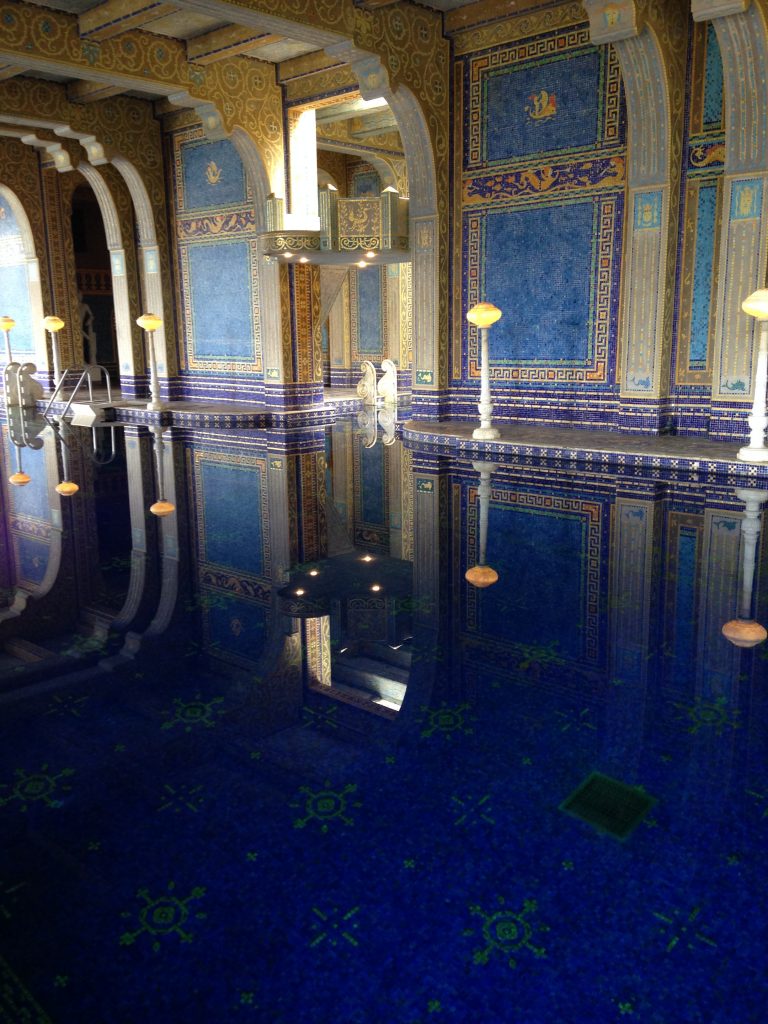
Founded in 1772 by the Franciscan priest Junípero Serra, it is one of the cities originally populated by the Chumash. Its history included dominance by Spain, then Mexico, and finally the United States. It also had an important Chinatown. Its Carnegie Library, built in 1905, is Romanesque in style and is on the National Register of Historic Places. Its Downtown is near Mission San Luis Obispo de Tolosa. Built in 1792, the Mission has a church that is still active today.
Its Fremont Theater, with its large murals inside, is in the Art Deco style of the 1940s. Its small SLO Museum of Art offers exhibitions, mainly contemporary art from California.
Neptune’s pool is being restored but the interior, Roman Pool (1927-34), is my favorite, with its beautiful Roman-style mosaics (smalti or blue enamel fused with gold), inspired by the Mausoleum of Galla Placidia (211-17 CE) in Ravenna, Italy. Around there are marble statues that copy the classics of Greece and Rome and that of the famous “The Scraper” from 320 B.C.E., from Lysippos. The ceiling is decorated by dark blue mosaics with stars.
We stayed at The Morgan San Simeon, nothing fancy, with a very nice view of the sea but no air conditioning, in a rather uncomfortable room and with a very bad breakfast. Anyway, almost no hotel in that area has air conditioning due to the cool climate, but in the summer, this can be a serious problem.
Big Sur, Point Lobos, Carmel, Monterey and the Argentine Corsair that conquered California for six days
On the way to Carmel, we passed through Big Sur, a “camping” area, beaches, restaurants and galleries. One of the most beautiful views is that of the Bixby Bridge, over the sea, built during the Depression by President Roosevelt. Its Pfeiffer Beach is considered one of the 10 best beaches in California.

We visited Point Lobos, on the northern tip of the Big Sur coast and very close (south of Carmel). It is the jewel of Californian parks, thanks to its spectacular views of the sea, rocks, hiking trails and majestic trees. This reserve is a wonder for nature lovers. It offers the opportunity to see sea lions (Sea Lion Point), whales in the spring, beautiful birds, the Cypress Forest Trail, wild flowers, and the Bird Island Trail. The views of China Cove and Gibson Beach are especially beautiful and in spring you can see seals from the bay.

The first thing we did when we arrived in Carmel-by-the-Sea, a small, very European city that has inspired artists and actors like Clint Eastwood, was visit the historic Mission Ranch Restaurant, which was restored by Eastwood when he was mayor. They do not accept reservations and to sit and have a drink in front of the beautiful meadow where the sheep graze, with the view of the Santa Lucia Mountains in the distance, you have to arrive very early, almost at 3:30 p.m. because the spaces are very scarce. We also recommend dining in the restaurant as the food is delicious and very organic. The bar where a pianist plays is fun too and I was told that Eastwood visits often. It also has a hotel and spaces for weddings and special events.

Carmel is one of the most attractive destinations in the US. It has a picturesque beach, interesting shops, gourmet restaurants, and historical places such as the Mission of San Carlos de Borromeo. The Mission, led by Fray Junípero Serra from 1770 until his death in 1784, was restored in 1884. It continues to function as a Catholic church (basilica) today and has an original bell tower. It is also a museum that preserves the history of the region, including that of the Convent, which has the cell where Serra lived and a chapel where his clothes are exhibited.
I noticed that due to their charm and fame, Carmel hotels in high season charge much more than in other cities and many do not have air conditioning. We stayed at the Best Western Plus, very close to shops and restaurants but it had no air conditioning, the room was very small and faced a corridor where guests and staff passed (very noisy). Breakfast was also very mediocre. Anyway, for $250 a night, it was uncomfortable and too expensive for what it offered.
Near Carmel we visit Monterey, whose peninsula is a meeting place for land, sea and sky. There we visit the Presidio Historic Park where there is an abandoned stone with a plaque commemorating Bouchard’s attack on California. In its interesting Museum we saw an exhibition of historical objects that told the history of Monterey and the role played by Corsair Hyppolite Bouchard, who fought for Argentina. Although born in France, he is considered the first Argentine to circumnavigate the world. During his voyage aboard the ship “La Argentina” he blocked the port of Manila in the Philippines.
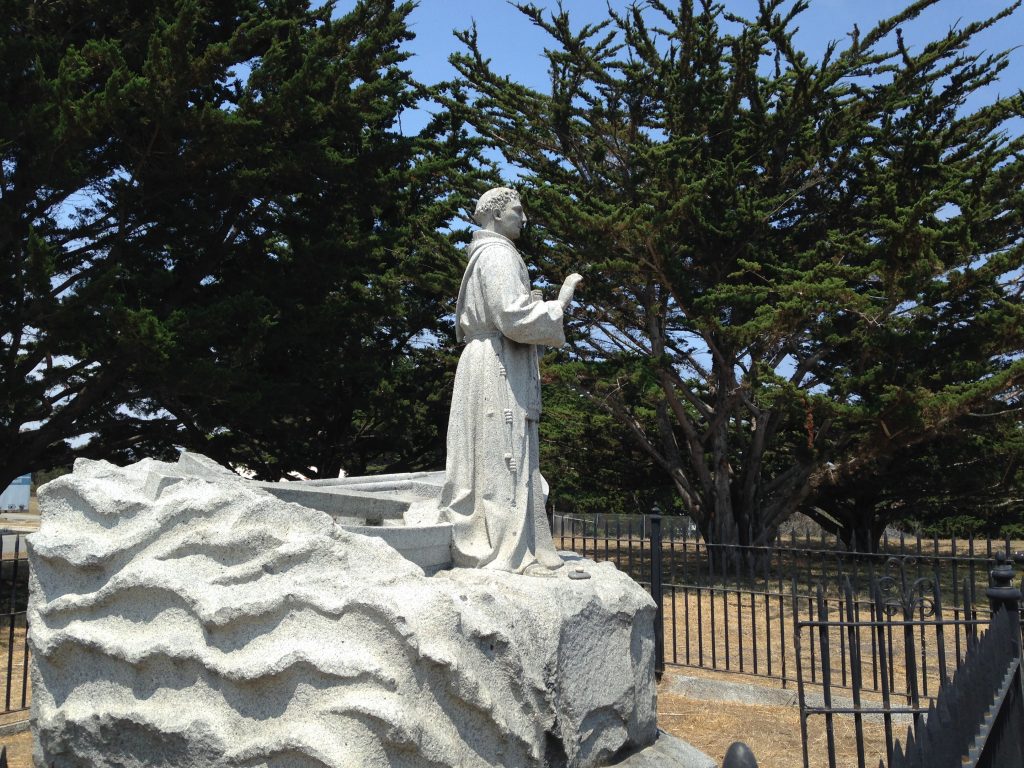
Under his command one of his small ships, in 1818, the Santa Rosa, attacked Monterey, then a Spanish colony, and anchored near the Presidio. At first the Spanish defeated the first Argentine attackers. At last, 200 of his men attacked the fort and within an hour they conquered it and placed the Argentine flag on it. For six days Argentina occupied Monterey and Bouchard’s forces stole the cattle and burned the fortress, the governor’s residence, and the Spanish mansions. Bouchard was especially upset that the Spanish Governor, Pablo Vicente de Solá, had taken the most valuable objects as well as gunpowder out of the city. In the museum we confirmed the bad temper that was attributed to Bouchard because they include his message to the inhabitants of Monterey.

In December he tried to conquer Santa Barbara but failed and sacked Mission San Juan de Capistrano in Southern California, burning the houses of the Spanish.
Thanks to Bouchard’s exploits against the Spanish, California was Argentine for six days.
Walt Disney, Salvador Dalí and J. M. W. Turner in San Francisco
San Francisco is famous for the Golden Gate Bridge, its hilltop city, its streetcars, its extraordinary views of the sea, its history as a center for the search for gold, its great fire, its Victorian “painted houses”, its redwoods. giants in Muir Woods, its historic neighborhoods and so many other attractions that it is undoubtedly one of the most important destinations in the world.

We stayed at the Omni San Francisco, an elegant, traditional hotel with all the modern advances. From there we explore various tourist attractions, from Union Square and Chinatown to the Embarcadero. In a spacious bedroom with a very comfortable bed and a luxurious bathroom, we were able to recover from the walks and walks of each day. The first night we had dinner at the hotel restaurant, Bob’s Steakhouse, and it not only served exquisite meat but also delicious lobster and fresh fish.

During our stay we visited one of the most interesting exhibitions I have seen in a museum: “La Pintura Liberada.” The De Young Museum brought in many of J. M. W. Turner’s finest paintings to illustrate various periods of his prolific work from his 60th birthday to his death in 1851. My favorites were the Venetian works and the maritime paintings. Turner was obsessed with the effects of light and some of his paintings seem to have been produced by an abstract painter of the s. XX. In fact, many of the Victorian critics of his day rejected his visionary art, especially that of the end of his life. The museum is located in the beautiful Golden Gate Park and contains 27,000 works, from American and European art of all periods to Oriental and African art. Among his most notable works are paintings by Canaletto, Picasso, Dalí, Sisley, Sorolla, Brueghel the Elder, Kokoschka, Modigliani, Tintoretto, Sir Joshua Reynolds, Fragonard, and many more.

Next to the De Young Museum is the Japanese Tea Garden, where we have tea with the most delicious sandwiches I’ve ever had, and then enjoyed the beauty and tranquility that its harmonious gardens offer. It was created as a result of the “Japanese Town” that was created for the International Exposition of 1894. It has an arched door, pagodas, lanterns and stone paths, Japanese plants and beautiful lagoons. Cherry blossoms bloom in the spring like in Japan.
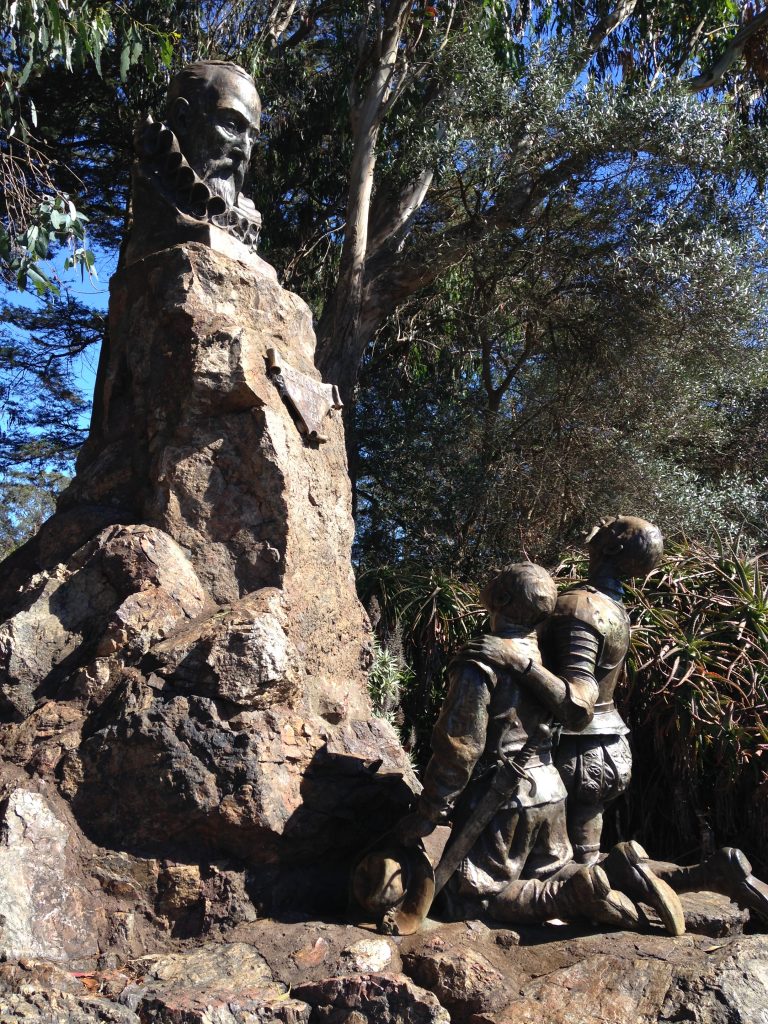
One of the most fascinating discoveries of this trip was the exhibition of the collaboration that existed between Walt Disney and Salvador Dalí. Disney and Dalí: Architects of Imagination is an exhibition that will last at the Walt Disney Family Museum, located in the Presidio area of San Francisco. Curated by Ted Nicolaou, it offers an experience of the extraordinary relationship between the brilliant Spanish surrealist painter and innovative Walt Disney.
 Five Day Travel.Com
Five Day Travel.Com 